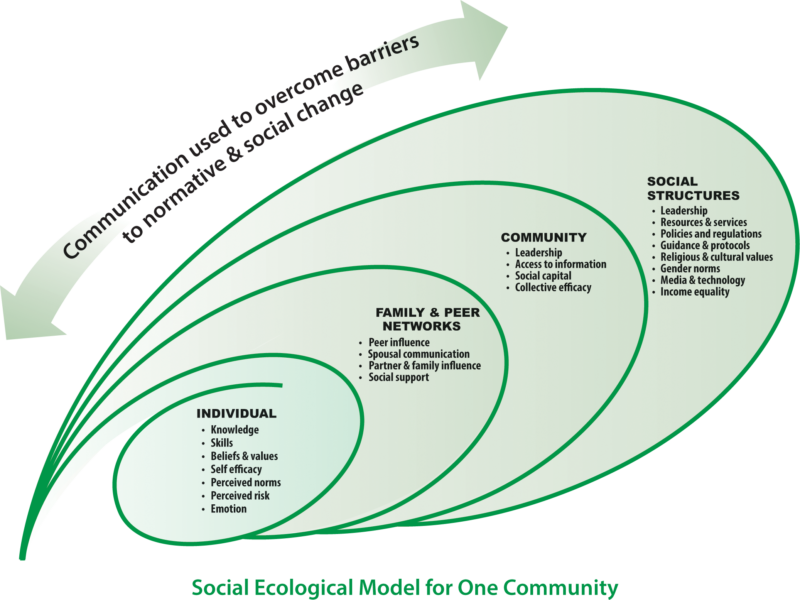Many factors influence the behavior of individuals, families, communities, service providers and leaders. The Social Ecological Model summarizes how SBCC can influence changes among each of these groups. Behavior among any of these groups can influence the behavior of other groups of people. Effective SBCC involves analyzing how this works, and designing SBCC activities that strategically address the key factors influencing behavior across these different groups of people.
 Take the example of a mother living in a rural village in sub-Saharan Africa, who purchases malaria medicine when her child is sick with malaria. All of the factors at each level of the Social Ecological Model should be considered when developing a program to raise her awareness of SSFFC malaria medicines and promote positive purchasing and reporting behaviors.
Take the example of a mother living in a rural village in sub-Saharan Africa, who purchases malaria medicine when her child is sick with malaria. All of the factors at each level of the Social Ecological Model should be considered when developing a program to raise her awareness of SSFFC malaria medicines and promote positive purchasing and reporting behaviors.
At the individual and family level, this mother needs the information and skills to know that some malaria medicines are not good quality, how poor quality malaria medicine can harm her and her family members, what sources are more likely to sell poor/good quality medicines, how to verify medicine quality and how to respond if she suspects that a medicine is poor quality. In addition, she and her family need to feel strongly about the benefits of buying good quality medicine and the harm of poor quality medicine, so that they will take steps to protect themselves.
This mother is not the only person who determines whether or not she treats her child with good quality ACTs. She may be influenced by the attitudes and opinions of her husband, the health provider she takes her baby to and the vendor she buys medicine from. With this in mind, a supplementary set of activities may be conducted to educate husbands and fathers, health workers and medicine vendors, so that they also adopt practices that help ensure that this mother, and others like her, get good quality ACTs.
At the community level, there may be a need to mobilize and train leaders to provide proper guidance to community members about the importance of properly preventing and treating malaria. This can help establish social norms that prioritize testing at a health facility and treating with quality-assured medicines as opposed to buying malaria medicines from unregulated vendors without diagnostic testing.
At the social/structural level, advocacy could be employed to strengthen systems that regulate medicine quality, enforce laws to protect medicine quality, track medicine quality and help consumers like this mother identify and report poor quality medicines. Advocacy can push for policies and laws that reduce the presence of SSFFC malaria medicines in the market.
At each level, there are factors that influence behavior in a positive way, called facilitators, or in a negative way, called barriers. Examples of facilitators are caring and concerned health workers, pharmacists and medicine vendors who are committed to distributing only good quality medicines, and trust in information provided by health and drug regulatory authorities. Examples of barriers include the belief that there is nothing consumers can do to protect themselves from poor quality medicines, lack of trust in the motives of regulatory authorities, or condescending service providers who discourage families from using health care services.
SBCC programs are strongest when they influence groups of people at multiple levels of the Social Ecological Model. Keep in mind ways of expanding impact, such as building partnerships and collaborating with organizations and institutions that operate at different levels.